The Rhineland-Palatinate is a medium-sized state on the western border of Germany. It is a relatively new administrative region formed after World War II, although the Palatinate region ('der Pfalz' in German) was a medieval area which covered the southern part of the current state..
The Palatinate is also a term which is used in wine production. The Palatinate area in wine terminology refers to a particular district in the southern part of the state.
Of course, the Palatinate is not the only wine-producing region in the state: there are five other important areas and, overall, the Rhineland-Palatinate has the largest cultivated area of vineyards in Germany.
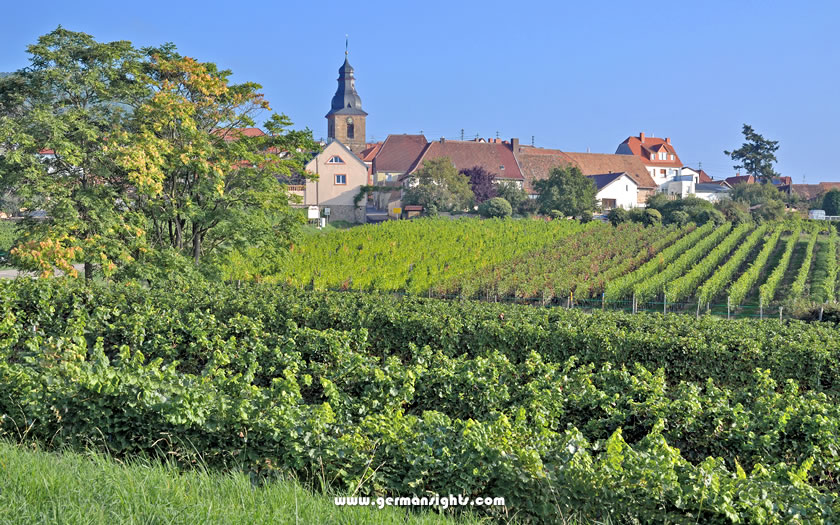
Vineyards near the village of Frankenweiler on the German Wine Route
Some of the remarkable cities in Rhineland-Palatinate include Mainz, Trier, and Koblenz. Each one offers a unique experience with their historical sites and cultural attractions.
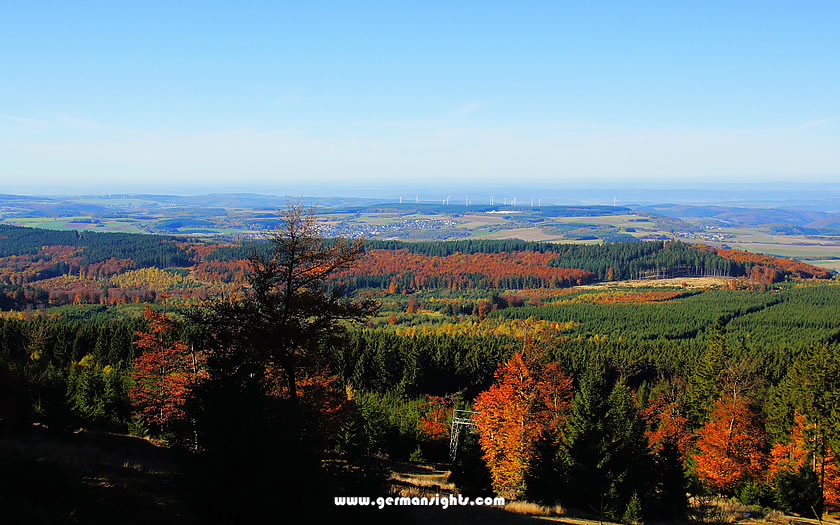
View from the Erbeskopf, the highest point in the Rhineland-Palatinate
Rhineland-Palatinate has a wide range of natural attractions, such as the Moselle river valley and the hiking trails in the Palatine Forest.
Find out more about how to get to and around Rhineland-Palatinate on our Rhineland-Palatinate travel page...

A view of Mainz across the Rhine river
Mainz is the capital of Rhineland-Palatinate and the largest city in the state with around 200,000 inhabitants.
The Mainz Cathedral, or Mainzer Dom, is one of the city’s most prominent landmarks. It dates back to the 10th century and has a mixture of Romanesque, Gothic, and Baroque architecture.
The city is known for its historic connection to printing. The city is home to the Johannes Gutenberg University, one of the largest universities in Germany. It is named after the inventor of movable type printing, who was born in Mainz. The Gutenberg Museum celebrates the invention.

A view over the Moselle river and the city of Trier
Trier is located near the border with Luxembourg in the Moselle wine region. It is the oldest city in Germany, with a history stretching back over 2,000 years.
Trier was founded by the Celts in the late 4th century BC and later became a significant city in the Roman Empire. Trier is home to several well-preserved Roman remains, including the Porta Nigra, the largest Roman city gate north of the Alps; the Imperial Baths; and the Trier Amphitheater.
Part of Trier has been designated a UNESCO World Heritage Site because of its rich architectural heritage.
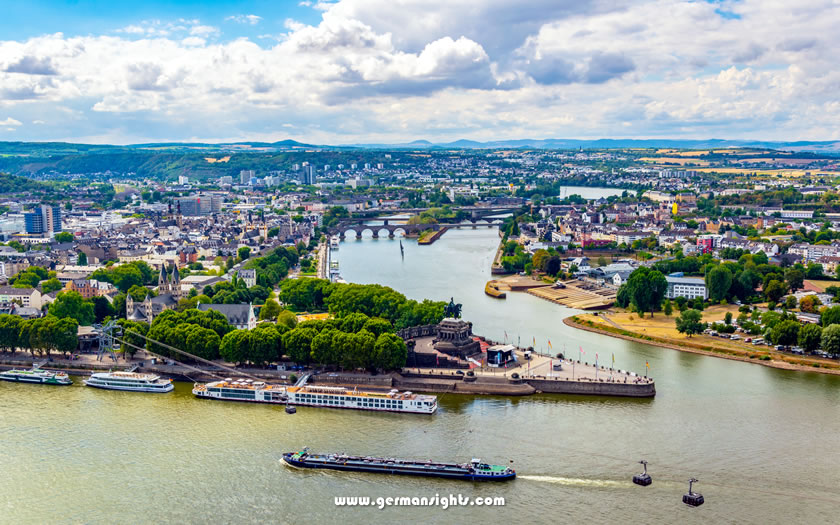
A view over the Mosel and Rhine at Koblenz
Koblenz is a city located at the confluence of the Rhine and Moselle rivers. It’s the third-largest city in the state of Rhineland-Palatinate, with a population of over 110,000.
Koblenz has a history that spans over 2,000 years, making it almost as old as Trier. It was established as a military post by the Romans in the year 8 BC.
One of the most famous landmarks in Koblenz is the Deutsches Eck ("German Corner"), which is where the Rhine and Moselle rivers meet. It is marked by a monumental equestrian statue of Emperor William I.
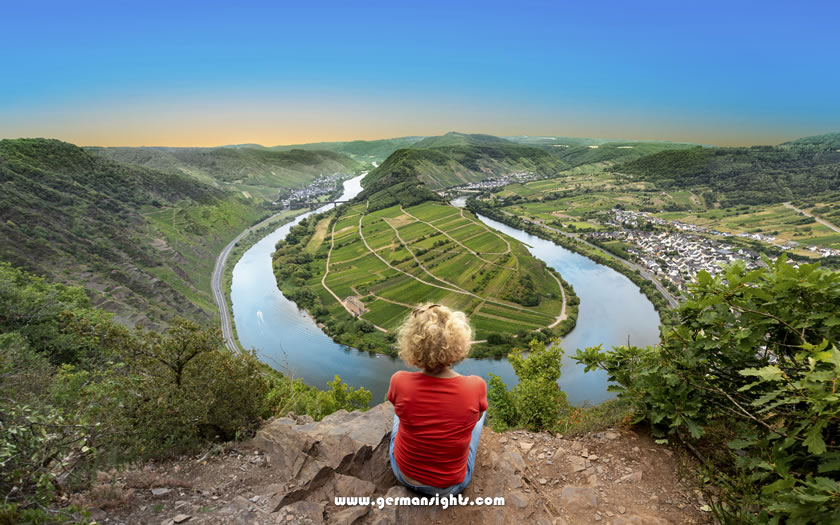
One of the scenic 'loops' in the Moselle valley
The Moselle valley is characterised by its steep vineyards, quaint villages, and medieval castles. It offers a range of outdoor activities such as hiking, biking, and river cruises.
The valley is especially known for its white wine production. The steep, sun-soaked slopes along the river create an ideal environment for vineyards. The region is particularly famous for its Riesling wines.
The region has a wealth of historical sites including the ancient city of Trier, Germany’s oldest city with numerous Roman remains, and the medieval Eltz Castle, which is still owned by the same family that lived there in the 12th century.
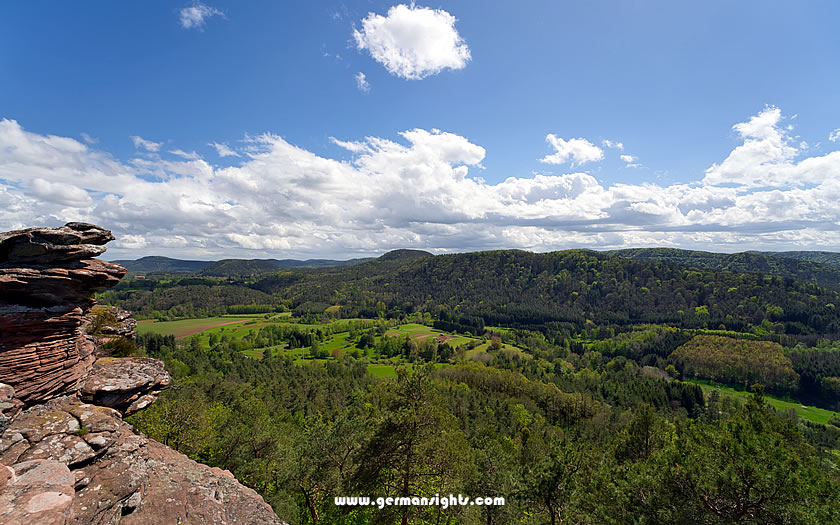
View from the Geiersteine rocks in the Palatinate Forest
The Palatinate Forest, known in German as the 'Pfälzerwald', is wooded region of low mountains in southwestern Germany. It is the largest continuous forest area in the country and is home to a diverse range of wildlife, including wild boar and deer.
Together with the French Northern Vosges, it forms the UNESCO Palatinate Forest-North Vosges Biosphere Reserve, one of the biggest forests in Europe.
It is a popular destination for outdoor activities and has an extensive network of hiking trails, including the Pfälzer Waldpfad long-distance trail.
The forest is dotted with numerous castles and ruins, many of which date back to the Middle Ages. Some of the most notable ones include Trifels Castle, Madenburg, and Hambach Castle.
The marketing pun on the official state name ("Weinland-Pfalz" vs "Rheinland-Pfalz") gives visitors an idea of how important wine production is here. The region is quite literally a paradise for any wine lover.
Rhineland-Palatinate can boast six main wine-producing regions: Palatinate, Rhine-Hesse, Nahe, Ahr, Moselle, and Middle-Rhine.
Palatinate (Pfalz): This region is renowned for its Riesling, but it also produces a wide variety of other wines such as Gewürztraminer and Dornfelder. It is one of the warmest regions in Germany, with vineyards stretching from the Rhine up to the Haardt mountain range.
Rhine-Hesse (Rheinhessen): This is the largest wine-producing region in Germany, known for its semi-sweet Liebfraumilch-style wines. It also produces a range of other wines including Silvaner, Riesling, and Dornfelder.
Nahe: Named after the river that traverses it, this region is known for its mineral-rich soils that contribute to the high quality of its wines. The Rieslings from here are particularly distinctive, with a balance of fruity acidity and mineral notes.
Ahr: This is one of the smallest wine regions in Germany, but it is also one of the most notable. It is particularly known for its red wines, especially its Pinot Noir (Spätburgunder). The region’s steep vineyards along the Ahr river valley provide an ideal microclimate for red grape cultivation.
Moselle (Mosel): This region is perhaps the most famous of all German wine regions. The slate soils of its steep vineyard terraces along the Moselle river contribute to the distinctively crisp and mineral Rieslings that it produces.
Middle Rhine (Mittelrhein): This small region stretches along the Rhine river. It is characterised by its steep, terraced vineyards and is particularly known for its Riesling wines. The region’s picturesque landscape with numerous castles and ruins has contributed to it being designated a UNESCO World Heritage Site.
Apart from its wines, Rhineland-Palatinate is also known for its regional cuisine sourced locally. Expect to see vegetables from the Hunsrück and Westerwald, fish from the Rhine and Moselle, and venison dishes from the Palatinate and Eifel.
Rhineland-Palatinate boasts a rich cultural heritage with several UNESCO World Heritage sites.
The Upper Middle Rhine Valley is a picturesque region characterized by its stunning landscapes, vineyards, and historic castles. This 65 km stretch along the Rhine River is the perfect destination for visitors seeking a romantic getaway or a leisurely cruise.
Another World Heritage site worth exploring is the ancient Roman city of Trier. Trier is home to an impressive collection of Roman ruins, including the famous Porta Nigra, the largest Roman city gate north of the Alps.

The Porta Nigra (or 'Black Gate') in Trier
The SHUM cities of Speyer, Worms, and Mainz are known for their significant Jewish heritage, recognised by UNESCO when sites from these cities were inscribed on the World Heritage List in 2021. The inscription includes Speyer's Jewish courtyard, Worms' Holy Sand cemetery, and Mainz's Old Jewish Cemetery.
"SHUM" is an acronym derived from the initial letters of the Hebrew names for Speyer (Shpira), Worms (Varmaisa), and Mainz (Magenza). These cities were important centers of Jewish life and learning during the Middle Ages, often referred to as the "Jerusalem of the North".
Mainz Carnival (Mainzer Fastnacht): One of the largest and most traditional Fasching carnivals in Germany. It is celebrated with parades, costume balls, and various events from November to Ash Wednesday, with the peak celebrations taking place in February.
Rhine in Flames (Rhein in Flammen): A series of firework displays that take place along the most picturesque stretches of the Rhine river from May to September.
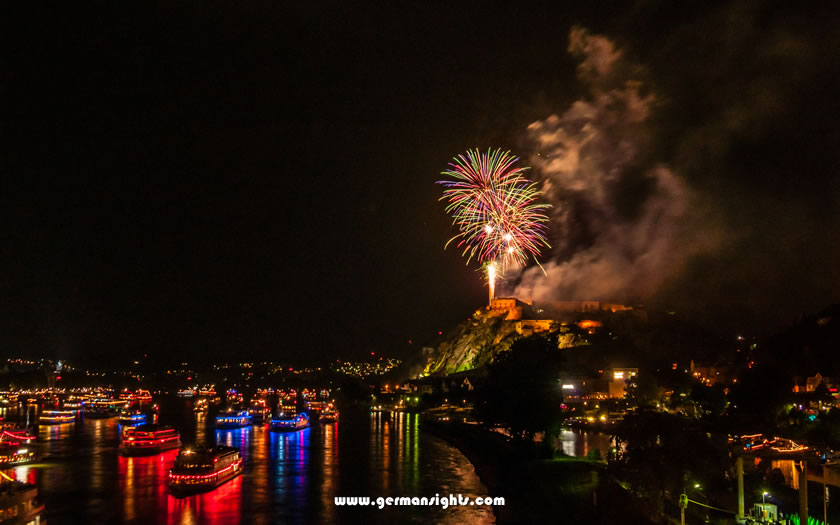
The 'Rhine in Flames' festival in Koblenz
Wine festivals: The world's largest wine festival is the Bad Dürkheim Wurstmarkt. It is held on the middle two weekends in September and can be thought of as the wine equivalent of the Munich Oktoberfest. Other notable festivals include the Deidesheimer Weinkerwe and the Middle Mosel Wine Festival in Bernkastel-Kues.
Nürburgring: The Nürburgring race track to the west of Koblenz hosts various motor sport events throughout the year, including the 24 Hours Nürburgring race and the F1 German Grand Prix.
If you know when you are planning to go but haven't decided on accommodation, then use the map below to get an idea of which properties are available and to compare prices during the period you wish to travel.
Enter your proposed dates and use the '+' to zoom in on a location and reveal more properties. Click on the price above a property to see more information.
(Please note that this selection will also include some guesthouses, pensions and self-catering apartments for those who are interested in that form of accommodation!)